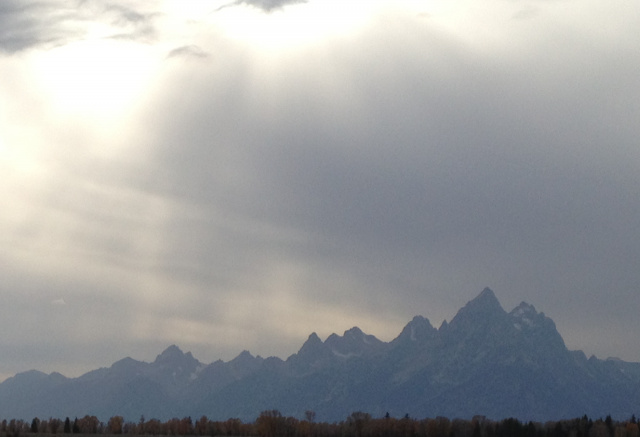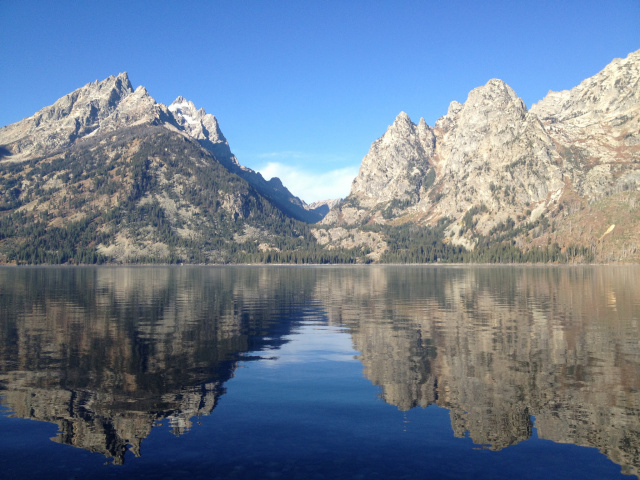Grand Tetons
The Grand Teton Mountain Range
The Mountains
Formed nine million years ago, the spires of the Grand Teton mountains are situated along the spine of North America's Rocky Mountains, and rise dramatically more than 7,000 feet above the lakes and sagebrush valley floor below. The dramatic impact of seeing the Teton Range has been likened to seeing "the mountains of a child's fables".
The Wildlife
The valley floor below the Teton range is rich in wildlife, providing home to moose, pronghorn, beavers, a herd of a thousand bison, and in winter, foraging for the stately Elk. 300 different birds and mammals including predators such as the grey wolf, coyote and grizzly bear live or journey through the Grand Tetons and surrounds.
A World formed by Glaciers
A necklace of lakes surrounds the base of the eastern escarpment of the Teton Range. These are the remnants of large glaciers which occupied nearby canyons and gouged out these depressions during the last ice age between 30,000 and 12,000 years ago.
The loveliness of America
"You must search for the loveliness of America; it is not obvious; it is scattered; but when you find it, it touches you and binds you to it like a great secret oath taken in silence." - Struthers Bert, Jackson Hole Rancher, 1934
The Grand Tetons Mountain Range
The Grand Tetons are a mighty mountain range in Jackson county, Wyoming, that is situated along the spine of North America’s Rocky Mountains. The striking rocky peaks of the Teton range rise more than 7,000 feet above a wildlife rich sagebrush valley floor.
These formations of the Teton mountains are carpeted in forests, whilst the valley floor is rich in wildlife and in summer come alive with wildflowers. Crystal clear streams and cascades run off the Teton range, into rocky canyons and lakes that reflect a mirror-image of the mountainside. The grand Snake River winds its way through the valley floor.
Most of the exposed rocks of the eastern Tetons were formed about 3 billion years ago – and so are two thirds as old as the Earth itself.
The glaciated valley below the Tetons supports sagebrush, coarse grasses and other plants, whilst the streams support aspen and cottonwood trees, with sedges growing in the marshes.
These plant communities in turn support moose, pronghorn, beavers, a herd of a thousand bison, and provide winter foraging for the stately Elk. 300 different birds and mammals live or journey through the Grand Tetons and surrounds. Amongst these include predators such as the pine marten, grey wolf, coyote and the cougar, along with the grizzly bear.
The conservation of the magnificent landscape of the Grand Tetons was subject to a fierce 50-year battle over its future in the 20th century. Cattlemen, politicians, “state’s righters”, Wyoming officials, conservationists and Park leaders all argued, fought and sued each other over the future of the Grand Tetons and its surrounding valley floor, before ultimately resolving to create a Grand Teton National Park, in what author Robert Richter has suggested is “…perhaps the most notable conservation victory of the twentieth century.”
Today, Jackson country has been transformed by the presence of such a magnificent protected landscape, and bases its identity around a celebration of nature. Dozens of conservation groups continue the effort to ensure for the maintenance and expansion of the protected landscapes around the Teton ranges, through practical conservation work, private land conservation purchases and other ongoing critical efforts for nature.
More Information about the Grand Tetons:
The US National Park Service – manages the Grand Tetons National Park: https://www.nps.gov/grte/index.htm
Current Conservation Efforts:
The Jackson Hole Land Trust – works to protect and steward the treasured landscapes near the Grand Teton’s: https://jhlandtrust.org/
The Grand Teton National Park Foundation – funds projects that enhances the Grand Teton National Park: https://www.gtnpf.org
The National Parks Conservation Association – works to conserve America’s National Parks: https://www.npca.org/parks/grand-teton-national-park

'Heart-lifting Scenery...'
“A beautiful piece of wild country in which people love to roam, and heart-lifting scenery. And a bit of wild history … something which will never be exhausted."
— Jackson Hole naturalist Margaret Murie

